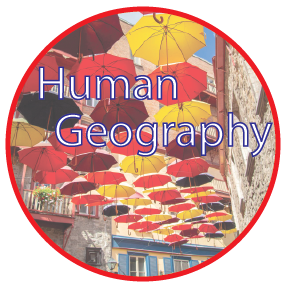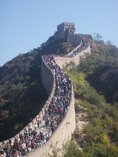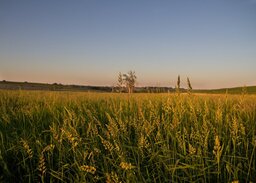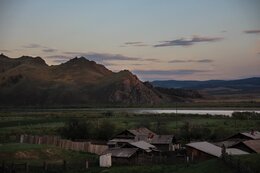Welcome to Geography 1020: Introduction to Human Geography!
|
Welcome to Geography 1020: Introduction to Human Geography. This course is designed to introduce students to the systematic study of patterns and processes that have shaped human understanding, use, and alterations of the Earth’s surface. Throughout the semester students will seek to understand the demographic, agricultural, urban, economic, political, and cultural forces that shape the way that humans interact with one another spatially. By examining maps and other geographical tools students will examine correlations between the physical and human world and the interactions that have shaped our understanding of our planet and human life on it.
UNO Course Description: An introductory course which studies the geography of human activity through a topic by topic coverage of cultural traits and complexes that characterize different societies in the world. Major cultural topics of focus are the geography of population, agricultural systems, settlement, language, religion, political patterns, and man's ways of occupying urban and industrial space, among others.
| |||||||
Unit I: Geographic Principles, and Establishing Populations
Week 1: Introduction to Geography
| |||||||||||||||||||||||||||||||
| Historical Perspectives of Geography | |
| File Size: | 4582 kb |
| File Type: | |
Module 1.2: Cartography and Mapwork
Objective: Students will use the elements of TODALSIGs to develop three different maps (at three different scales) and be able to identify and correctly analyze different forms of cartographic representations.
Direct Instruction: Cartographic Principles and Geospatial Technologies
Lecture Recording: LINK
Assessment: Applying Mapreading to Population Maps
Reading: Bjelland pgs. 20-30
Objective: Students will use the elements of TODALSIGs to develop three different maps (at three different scales) and be able to identify and correctly analyze different forms of cartographic representations.
Direct Instruction: Cartographic Principles and Geospatial Technologies
Lecture Recording: LINK
Assessment: Applying Mapreading to Population Maps
Reading: Bjelland pgs. 20-30
| Cartographic Principles and Geospatial Technologies | |
| File Size: | 3473 kb |
| File Type: | |
Week 2: Cartography and Geographic Inquiry
(August 29-Sept 2)
Module 1.3: Thematic Approach to Geography
Objective: Students will be able to identify how each of five themes of geography can be used to explain different aspects of an area by examining a case study of Iceland, and then applying the concepts to their own hometown.
Direct Instruction: Five Themes of Iceland
Lecture Recording: LINK
Assessment: Five Themes of Your Hometown
Reading: Bjelland pgs. 7-19
Objective: Students will be able to identify how each of five themes of geography can be used to explain different aspects of an area by examining a case study of Iceland, and then applying the concepts to their own hometown.
Direct Instruction: Five Themes of Iceland
Lecture Recording: LINK
Assessment: Five Themes of Your Hometown
Reading: Bjelland pgs. 7-19
| Five Themes of Iceland | |
| File Size: | 2701 kb |
| File Type: | |
Module 1.4: Geographic Inquiry
Objective: Students will learn about how the geoinquiry process differs from other forms of study and the unique perspectives geography has in its questioning by covering notes on the topic and being able to use information from the topic to answer geographic questions.
Direct Instruction: The Geoinquiry Process
Lecture Recording: LINK
Assessment: Concepts from this module will be covered by the end of unit assessment
Reading: Esri - Geographic Inquiry - Thinking Geographically
Objective: Students will learn about how the geoinquiry process differs from other forms of study and the unique perspectives geography has in its questioning by covering notes on the topic and being able to use information from the topic to answer geographic questions.
Direct Instruction: The Geoinquiry Process
Lecture Recording: LINK
Assessment: Concepts from this module will be covered by the end of unit assessment
Reading: Esri - Geographic Inquiry - Thinking Geographically
| The Geoinquiry Process | |
| File Size: | 965 kb |
| File Type: | |
| Esri - Geographic Inquiry: Thinking Geographically | |
| File Size: | 679 kb |
| File Type: | |
Week 3: Population
|
Week 4: Migration
|
|
Module 1.5: Population Theories and Models
Objective: Students will learn about the guiding principles of study in demography and population geography and be able to read models and maps of geographic data related to the study of populations and their distributions. Direct Instruction: A Geographic Approach to Population Lecture Recording: LINK Assessment: Concepts from this module will be covered by the end of unit assessment Reading: Bjelland pgs. 97-118
Module 1.6: Population Distributions & Policies
Objective: Students will learn about the impact that the physical environment has on the sizes and distributions of human populations by covering notes on the topic and being able to recall on the end of unit exam. Direct Instruction: Ecumene & Human Habitation Lecture Recording: LINK Assessment: Population Quiz Reading: Bjelland pgs. 118-123
|
Module 1.7: Migration Theories
Objective: Students will understand the concepts related to the movements of people across the planet and how they connect to the study of population geography. Direct Instruction: Principles of Migration Lecture Recording: LINK Assessment: Concepts from this module will be covered by the end of unit assessment Reading: Bjelland pgs. 74-83
Module 1.8: Patterns of Migration
Objective: Students will learn about Ravenstein's theory on patterns of migration and be able to use principles to relate to modern examples found in current events. Direct Instruction: Models and Patterns of Migration Lecture Recording: LINK Assessment: Finding Ravenstein Reading: Bjelland pgs. 64-74
| ||||||||||||||||||||||||
Week 5: Migration & Urban
| |||||||||||||||||||
| Analyzing Migration | |
| File Size: | 1852 kb |
| File Type: | |
Module 1.10: Urbanization
Objective: Students will understand the classification of urban areas and be able to identify specific urban examples to match definitions.
Direct Instruction: Geography of Urban Areas
Lecture Recording: LINK
Assessment: Urban Identities
Reading: Bjelland pgs. 350-365
Objective: Students will understand the classification of urban areas and be able to identify specific urban examples to match definitions.
Direct Instruction: Geography of Urban Areas
Lecture Recording: LINK
Assessment: Urban Identities
Reading: Bjelland pgs. 350-365
| Geography of Urban Areas | |
| File Size: | 2164 kb |
| File Type: | |
Week 6: Urban & Test
(September 26-30)
Module 1.11: Urban Organization & Models
Objective: Students will be able to identify urban models and apply them to their ability to understand the structure of urban areas across North America and the globe.
Direct Instruction: Urban Structure
Lecture Recording: LINK
Assessment: Concepts from this module will be covered by the end of unit assessment
Reading: Bjelland pgs. 365-393
Objective: Students will be able to identify urban models and apply them to their ability to understand the structure of urban areas across North America and the globe.
Direct Instruction: Urban Structure
Lecture Recording: LINK
Assessment: Concepts from this module will be covered by the end of unit assessment
Reading: Bjelland pgs. 365-393
| Urban Structure | |
| File Size: | 3849 kb |
| File Type: | |
Module 1.12: Unit Test
Objective: Students will be able to recall and apply principles from throughout the course of the unit by taking an examination.
Assessment: Unit I Test - Geographic Principles and Establishing Populations
+ Unit I Study Guide
Objective: Students will be able to recall and apply principles from throughout the course of the unit by taking an examination.
Assessment: Unit I Test - Geographic Principles and Establishing Populations
+ Unit I Study Guide
Unit II: Economic Activities in a Rural and Urban Landscape
Week 7: Natural Resource & Rural Organization
| |||||||||||||||||||||||||
| Rural Land Divisions | |
| File Size: | 2408 kb |
| File Type: | |
Module 2.2: Natural Resources and Energy
Objective: Students will be able to tell the difference between renewable and non-renewable resources, their spatial distributions and uses.
Direct Instruction: Geography of Resources
Lecture Recording: LINK
Assessment: Concepts from this module will be covered by the end of unit assessment
Reading: Bjelland pgs. 271-285
Objective: Students will be able to tell the difference between renewable and non-renewable resources, their spatial distributions and uses.
Direct Instruction: Geography of Resources
Lecture Recording: LINK
Assessment: Concepts from this module will be covered by the end of unit assessment
Reading: Bjelland pgs. 271-285
| Geography of Resources | |
| File Size: | 5083 kb |
| File Type: | |
Week 8: Origins of Agriculture & Human Imprint
(October 10-14)
Module 2.3: Human Imprint on the Environment
Objective: Students will learn about the ways in which humans have had an impact on the environment and be able to recognize imprints on the landscapes.
Direct Instruction: Pollutants and Human Imprint
Lecture Recording: LINK
Assessment: Concepts from this module will be covered by the end of unit assessment
Reading: Bjelland pgs. 432-463
Objective: Students will learn about the ways in which humans have had an impact on the environment and be able to recognize imprints on the landscapes.
Direct Instruction: Pollutants and Human Imprint
Lecture Recording: LINK
Assessment: Concepts from this module will be covered by the end of unit assessment
Reading: Bjelland pgs. 432-463
| Pollutants and Human Imprint | |
| File Size: | 2341 kb |
| File Type: | |
Module 2.4: Developments in Agriculture
Objective: Students will learn about the philosophical and technological developments over space and time.
Direct Instruction: Revolutions in Agriculture
Lecture Recording: LINK
Assessment: Debating GMOs
Reading: N/A
Objective: Students will learn about the philosophical and technological developments over space and time.
Direct Instruction: Revolutions in Agriculture
Lecture Recording: LINK
Assessment: Debating GMOs
Reading: N/A
| Revolutions in Agriculture | |
| File Size: | 3390 kb |
| File Type: | |
Week 9: Agricultural Geography
| |||||||||||||||||||||||||
| Agriculture in Less Developed Countries (LDCs) | |
| File Size: | 3008 kb |
| File Type: | |
Module 2.6: Agricultural Regions
Objective: Students will examine and apply geographic models related to the distribution of agricultural practices in More Developed Countries and evaluate their applications on multiple scales.
Direct Instruction: Agriculture in More Developed Countries (MDCs)
Lecture Recording: LINK
Assessment: Nebraska and Von Thunen
Reading: Bjelland pgs. 260-271
Objective: Students will examine and apply geographic models related to the distribution of agricultural practices in More Developed Countries and evaluate their applications on multiple scales.
Direct Instruction: Agriculture in More Developed Countries (MDCs)
Lecture Recording: LINK
Assessment: Nebraska and Von Thunen
Reading: Bjelland pgs. 260-271
| Agriculture in More Developed Countries (MDCs) | |
| File Size: | 2082 kb |
| File Type: | |
Week 10: Industrial Geography
(October 24-28)
Module 2.7: Historical Distributions of Economic Development
Objective: Students will examine the philosophical and technological developments that took place during the industrial revolution over space and time.
Direct Instruction: Systems of Industrialization
Lecture Recording: LINK
Assessment: Concepts from this module will be covered by the end of unit assessment
Reading: Bjelland pgs. 332-346
Objective: Students will examine the philosophical and technological developments that took place during the industrial revolution over space and time.
Direct Instruction: Systems of Industrialization
Lecture Recording: LINK
Assessment: Concepts from this module will be covered by the end of unit assessment
Reading: Bjelland pgs. 332-346
| Systems of Industrialization | |
| File Size: | 3735 kb |
| File Type: | |
Module 2.8: Geography of Industrial Development
Objective: Students will examine the importance of site and situation to the development of industry and the application of geographic models to justify industry location.
Direct Instruction: Site and Situation Factors in Industrialization
Lecture Recording: LINK
Assessment: Diffusion of Industrialization
Reading: Bjelland pgs. 288-314
Objective: Students will examine the importance of site and situation to the development of industry and the application of geographic models to justify industry location.
Direct Instruction: Site and Situation Factors in Industrialization
Lecture Recording: LINK
Assessment: Diffusion of Industrialization
Reading: Bjelland pgs. 288-314
| Site and Situation Factors in Industrialization | |
| File Size: | 2698 kb |
| File Type: | |
Week 11: Industrial Development & Test
| |||||||
| Factors of Development | |
| File Size: | 3595 kb |
| File Type: | |
Module 2.10: Unit Test
Objective: Students will be able to recall and apply principles from throughout the course of the unit by taking an examination.
Assessment: Unit II Test - Economic Activities in a Rural & Urban Environment
+ Unit II Study Guide
Objective: Students will be able to recall and apply principles from throughout the course of the unit by taking an examination.
Assessment: Unit II Test - Economic Activities in a Rural & Urban Environment
+ Unit II Study Guide
Unit III: Cultural and Political Organization of Human Systems
Week 12: Cultural Geography
| |||||||||||||||||||||||||
| Cultural Understandings | |
| File Size: | 6024 kb |
| File Type: | |
Module 3.2: Cultural Diffusion
Objective: Students will examine the patterns through which culture diffuses and be able to apply their learnings through explaining a historic example of cultural diffusion.
Direct Instruction: Spreading Cultural Traits
Lecture Recording: LINK
Assessment: Cultural Diffusion Examples
Reading: Bjelland pgs. 48-61
Objective: Students will examine the patterns through which culture diffuses and be able to apply their learnings through explaining a historic example of cultural diffusion.
Direct Instruction: Spreading Cultural Traits
Lecture Recording: LINK
Assessment: Cultural Diffusion Examples
Reading: Bjelland pgs. 48-61
| Spreading Cultural Traits | |
| File Size: | 1472 kb |
| File Type: | |
Week 13: Viewing Culture Geographically
(November 14-18)
Module 3.3: Distributions of Cultural Traits
Objective: Students will examine examples and case studies of cultural diffusion through further examining traits and patterns of religious and linguistic systems.
Direct Instruction: Geography of Language & Religion
Lecture Recording: LINK
Assessment: Concepts from this module will be covered by the end of unit assessment
Reading: Bjelland pgs. 175-207
Objective: Students will examine examples and case studies of cultural diffusion through further examining traits and patterns of religious and linguistic systems.
Direct Instruction: Geography of Language & Religion
Lecture Recording: LINK
Assessment: Concepts from this module will be covered by the end of unit assessment
Reading: Bjelland pgs. 175-207
| Geography of Language & Religion | |
| File Size: | 2883 kb |
| File Type: | |
Module 3.4: Culture’s Imprint on the Landscape
Objective: Students will examine and be able to examine a landscape critically to the point of being able to identify significance of human impact on a landscape and influences of physical features on development of human systems.
Direct Instruction: The Cultural Imprint
Lecture Recording: LINK
Assessment: Finding the Cultural Landscape
Reading: Bjelland pgs. 227-244
Objective: Students will examine and be able to examine a landscape critically to the point of being able to identify significance of human impact on a landscape and influences of physical features on development of human systems.
Direct Instruction: The Cultural Imprint
Lecture Recording: LINK
Assessment: Finding the Cultural Landscape
Reading: Bjelland pgs. 227-244
| The Cultural Imprint | |
| File Size: | 2191 kb |
| File Type: | |
Week 14: Introduction to Political Geography
| |||||||||||||||||||||||||
| The Political Landscape | |
| File Size: | 3881 kb |
| File Type: | |
Module 3.6: Establishing Borders and Territory
Objective: S
Direct Instruction: Forming Borders
Lecture Recording: LINK
Assessment: A
Reading: Bjelland pgs. 405-408
Objective: S
Direct Instruction: Forming Borders
Lecture Recording: LINK
Assessment: A
Reading: Bjelland pgs. 405-408
| Forming Borders | |
| File Size: | 3820 kb |
| File Type: | |
Week 16: Political Complications
(December 12-16)
Module 3.9: Unit Test
Objective: Students will be able to recall and apply principles from throughout the course of the unit by taking an examination
Assessment: Unit III Test - Cultural & Political Organization of Human Systems
+ Unit III Study Guide
Objective: Students will be able to recall and apply principles from throughout the course of the unit by taking an examination
Assessment: Unit III Test - Cultural & Political Organization of Human Systems
+ Unit III Study Guide
Week 15: Political Alignments
(November 28-December 2)
Module 3.7: State Relationships and Sovereignty
Objective: S
Direct Instruction: State Relationships
Lecture Recording: LINK
Assessment: A
Reading: Bjelland pgs. 414-429
Objective: S
Direct Instruction: State Relationships
Lecture Recording: LINK
Assessment: A
Reading: Bjelland pgs. 414-429
| State Relationships | |
| File Size: | 4273 kb |
| File Type: | |
Module 3.8: Unifying and Dividing Forces
Objective: Students will learn about the complicating situations that the organization of human spaces based into political units can lead into and be able to identify specific examples.
Direct Instruction: Political Forces
Lecture Recording: LINK
Assessment: Unpolitical Political Forces
Reading: Bjelland pgs. 408-414
Objective: Students will learn about the complicating situations that the organization of human spaces based into political units can lead into and be able to identify specific examples.
Direct Instruction: Political Forces
Lecture Recording: LINK
Assessment: Unpolitical Political Forces
Reading: Bjelland pgs. 408-414
| Political Forces | |
| File Size: | 3832 kb |
| File Type: | |








